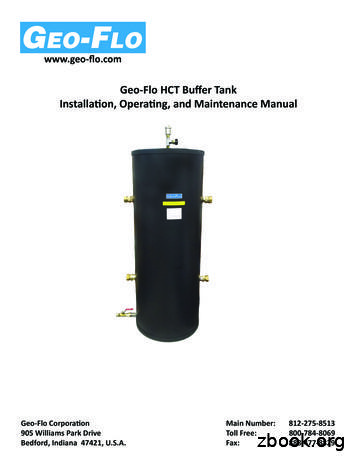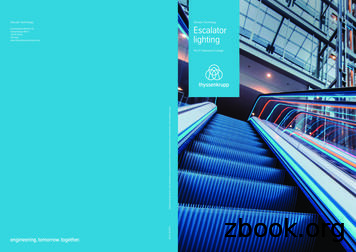SINGLE-STAGE ELECTROMAGNETIC ELEVATOR MODELLING
8th International DAAAM Baltic Conference"INDUSTRIAL ENGINEERING 19-21 April 2012, Tallinn, EstoniaSINGLE-STAGE ELECTROMAGNETIC ELEVATOR MODELLINGIN FEMM SOFTWARELapkovskis, V., Mironovs, V.maintenance of such conveyors is required.Moreover, powder raw materials arebecoming contaminated of wear products(particles). The electromagnetic conveyorcan be considered as a solution for certainindustrial applications, and especially inpowder metallurgy.One of the most demanding tasks is aconveying of ferromagnetic powders invertical pipes for further processing. As apossible solution the Powder MaterialsLaboratory of Riga Technical Universityhas designed a laboratory-scale singlestage electromagnetic system for powderconveying on short distances (up to 5meters) in pipes [5]. Scheme of laboratoryequipment EMC-05 [6] for ic fields is shown in Fig. 1.In our laboratory setup a power unit isproduced by HBS BolzenschweissSysteme GmbH [7] has been tor(conveyingdevice) designed in Riga TechnicalUniversity (Latvia) is described. Modellingof single-stage electromagnetic elevator inFEMM software is suggested. Analysis ofelectromagnetic field distribution createdby multi-turn coil used as propulsion meanfor conveying of ferromagnetic materialsby electromagnetic field is presented. Useof different coil materials and coildimensions is evaluated.Key words: electromagnetic elevator,FEMM software, coil1. INTRODUCTIONThere are many specific industrialapplications of electromagnetic fields:sensors, actuators, valves, vibrationagitators, particulate filters and a greatmany othertechnicalapplications.Amongst them there is a place for specificapplication of pulsed electromagnetic field,namely for conveying of ferromagneticmaterials in tubes. A millisecond impulseof electromagnetic field is acting as apropulsionmeanfor moving offerromagnetic materials inside a tube.Ferromagnetic powders manufacturingindustry is one of the end-users ofpresented approach [1].Nowadays manufacturers of ferromagneticpowders are using a traditional screw [2] ,belt conveyors, bucket elevators, chaintubular conveyors [3] or pneumaticconveying systems [4] for powderhandling. Due to extensive wear ofconstructionmaterials,aperiodicFig. 1. Schematic of the equipment usedfor ferromagnetic powders conveying byimpulse electromagnetic field.1 – transformer, 2 – rectifier, 3 – triac(thyristor), 4 – charging resistor, 5 –discharging thyristor, 6 – conveyor tract, 7– coil, 8 – ferromagnetic powder, 9 capacitor battery.321
devices where pulsed electromagneticfields are used [11]. In case of fine particles(or iron powders) the reluctance conveyingapproach was used [12]. A selectedapproach is based on the e material which provokeacceleration. FEMM modelling is realisedfor the computation of the force on a massof iron powder at various positions relativeto a wound air-cored coil.Schematically the approach for conveyingby electromagnetic fields is shown in Fig.2.For modelling of electromagnetic fielddistribution a set of wound air-core coilshas been used (Table 2.). A cross-sectionalview of coil is shown in Fig. 3.Fig. 2. Schematic ferromagnetic materialsconveying in vertical pipe.1 – pipe (conveyor tract), 2 –electromagnetic coil, 3 – reservoir filledwith ferromagnetic powder (iron powder),4 – gripping of ferromagnetic powder byimpulse electromagnetic field applied, 5 –coil connection to the generator ofelectromagnetic currents (power unit).Fig. 3. Coil cross-sectional view.w – winding thickness, mm; h – windingheight, mm; d – coil's internal (wound)diameter, mmIndustrial iron powders have iron content96.5-99.5%. Specifications of iron powderssuitablefortransportationbyelectromagnetic field are presented inTable 1.Particle size range,μm45-200Coil No.Windingmaterialw,h,d,mm mm mmCoil(01)Copper252550Coil(02) Aluminium 259050Coil(03)Copper 40 75 50Table 2. Electromagnetic coils used formodelling in FEMM.Fe content in powder 96.5-99.5(by weight), %Apparent density of 2.3-3.9powder, g/cm-3Table 1. Iron powders used for conveyingby impulse electromagnetic field.In order to evaluate an electromagneticlifting force for current model a set offerromagnetic powder bodies (cylindricalpowder fillings) has been defined (Fig. 4.,Table 3.)2. ELECTROMAGNETICCONVEYOR MODEL IN FEMMWe have chosen the FEMM - a powerfulfree software for electromagnetic problemsmodelling [8], [9]. FEMM is a 2D FEAsoftware package developed by Eng. D.Meeker [10].There are different models of acceleratorFig. 4. Powder bodies used for themodelling of electromagnetic elevator.322
Coil No CalculatedElectricalsource current conductivity ofdensity, MA/m2 wire material,MS/mLabel ofpowderbodyh 1 , mmr 1 , mma3525Coil(01) 0.60859.6b2525Coil(02) 0.15835c1525Table 3. Dimensions of ferromagneticpowder bodies used for modelling.Coil(03) 0.12359.6Table 4. Power source current density, andelectrical conductivity of coils.A schematic of electromagnetic elevatorinput geometry is shown in Fig. 5. Initially,the powder body is located underneath thecoil.The following assumptions of FEMMmodel have been taken into account: steadycurrent (in coil), no eddy currents,simulation for every position (shift) ofpowder body along the z-axis is calculatedfor the steady-state conditions. Example ofmagnetic field density plot for Coil(01) isshown in Fig. 6.Fig. 5. Electromagnetic elevator:axisymmetric model set-up in FEMM.1 - symmetry axis, 2 – iron powder, 3 –outer boundary of interior region, 4 – coilcross-section, 5 – interior region (air).Fig. 6. Magnetic field density plot forCoil(01).It was established experimentally that forthe laboratory device the minimal voltageof impulse current source when it ispossible to observe and register a liftingphenomenon of fine ferromagneticmaterials is 50 V. Thus, for the FEMMmodel the similar conditions have beenchosen. Coil electrical input parameters[13] for the model are shown in Table 4.Forevaluationofelectromagneticinteraction between coil and powder body,a programme written in Lua language [14]has been used. The following actions areperformed during an execution of Luascript:a) Shifting a powder body along z-axis,b) Performing a numerical analysis of themodel,c)Calculating z-directed componentof force for every position of powder body.323
3. RESULTSFig. 9. Force vs. distance between powderbody and coil centre modelling output forCoil(03) calculated for powder bodies (a),(b), (c).Output results of force vs. distancebetween powder body and coil centremodelling are presented below in Fig. 7, 8,9.1.20E-01Force via weighted tensor, N1.00E-01a8.00E-02bc6.00E-024.00E-022.00E-020.00E E-02-8.00E-02Distance between surface powder and coil centre, mmFig. 7. Force vs. distance between powderbody and coil centre modelling output forCoil(01) calculated for powder bodies (a),(b), (c).4. FURTHER RESEARCHForce via weighted tensor, 030.00E 00-60-50-40-30-20-100102030-5.00E-03Distance between surface powder and coil centre, mmFig. 8. Force vs. distance between powderbody and coil centre modelling output forCoil(02) calculated for powder bodies (a),(b), (c).The FEMM software is useful instrumentfor evaluation of different geometries andmaterials used in design of electromagneticelevator.Modelling approach has confirmed aprevious research on construction ofelectromagnetic conveying equipment.The following modelling is necessary forevaluation of combination of factorsinfluencing on the effectiveness ofelectromagnetic elevator.Force via weighted tensor, N5.00E-024.00E-02ab2.00E-02c1.00E-020.00E 00-60-50-40-30-20-1001020Further research is necessary for pilotequipment construction, which can be usedin real manufacturing facilities. Themodelling procedure can help in design oflow-energy pilot equipment for conveyingof ferromagnetic materials. Meanwhile, itis important to evaluate an influence ofelectromagnetic impulse fields on powdersegregation, especially in case ofcontinuous exploitation. FEMM softwarewill be used for modelling of differentmixingequipmentbasedonelectromagnetic phenomena [16].5. CONCLUSIONS6.00E-023.00E-02It is evident that coil's geometry plays animportant role in conveying model. ForCoil(02) and Coil(03) the maximum offorce is achieved at the entrance of coilwound or in the first half of coil's height. Inthe same time the highest force values havebeen shown by Coil(01). In fact, theexperiments confirm the effectiveness ofCoil(01) [15]. The best simulation resultshave been shown by coil made of copperwire e.i. Coil(01).30-1.00E-026. ADDITIONAL DATA ABOUTAUTHORS-2.00E-02Distance between surface powder and coil centre, mm324
Conveying Engineering. Marcel Dekker,2004.[5] V. Mironov, J. Viba, and V. agnetic powders in pipes /inRussian/,” Poroshkovaya metallurgiya, vol.33, pp. 53-59, 2010.[6] V. Lapkovskis and V. Mironovs,LaboratoryequipmentEMC-05.Introduction to conveying of ferromagneticpowders by impulsed electromagneticfield. 2012.[7] HBS, HBS CD 1501 Power Unit.Operating manual. 2005, p. 72.[8] K. B. Baltzis, “The FEMM Package: ASimple, Fast, and Accurate Open SourceElectromagnetic Tool in Science andEngineering,” J. of Engineering ScienceAnd Technology Rev., pp. 83-89, 2008.[9] S. Zurek, “Magnetic core with a coil.2D magnetostatic with FEMM 4.2,” 2008.[10] D. Meeker, Finite element MethodMagnetics v4.0, User’s Manual. 2006.[11] S. W. Kim, H. K. Jung, and S. Y.Hahn, “An optimal design of ns on, vol. 30, no. 2, pp. 207–211, 1994.[12] G. W. Slade, “A simple unifiedphysical model for a s on, vol. 41, no. 11, pp. 4270–4276, Nov. 2005.[13] D. J. Griffiths, Introduction toelectrodynamics, vol. 3. prentice Hall NewJersey:, 1999.[14] R. Ierusalimschy, L. H. de Figueiredo,and W. Celes, Lua 5.1 Reference Manual.Lua. org, 2006, pp. 1-19.[15] V. Lapkovsky, V. Mironov, A.Shishkin, and V. Zemchenkov, “Conveyingof Ferromagnetic Powder Materials byPulsed Electromagnetic Field,” in EuroPM2011 – Tools for Improving PM:Modelling & Process Control, 2011, pp.253-258.[16] V. Mironovs, V. Lapkovskis, and J.Baroniņš, “Method and device for mixingof powder materials,” LR Patentapplication 14383 A, 2011.Mr. Vjaceslavs Lapkovskis,Researcher.Azenes str. 16, lab. 331, LV-1048,Riga, Latvialap911@gmail.comwww.lab331.infoPh. ( 371) 29536301Mr. Viktors Mironovs.Dr.hab.Sc.ing.Azenes str. 16, lab. 331, LV-1048,Riga, Latviaviktors.mironovs@gmail.comwww.lab331.infoPh. ( 371) 67089270Corresponding Author:Mr. Vjaceslavs Lapkovskis,lap911@gmail.comPh. ( 371) 295363017. AKNOWLEDGEMENTSThis work has been supported by the EuropeanSocial Fund within the project “Support for theimplementation of doctoral studies at RigaTechnical University”8. REFERENCES.[1] S. Saito, J. Ohta, and M. Fujinaga,“JIP Iron Powder Products and TechnicalTrends in Powder Metallurgy,” jfesteel.co.jp, vol. 16, no. 16, 2011.[2] A. Kurjak, “The vertical screwconveyor- powder properties and Screwconveyor design (Master Thesis),” LundInstitute of Technology, 2005.[3] S. Schmolke, A. Katterfeld, and F.Krause, “Experimental Tests and Design ofTube Chain Conveyors,” wase.urz.unimagdeburg.de.[4] D. Mills, M. G. Jones, and V. K.Agarwal,HandbookofPneumatic325
Coil(02) and Coil(03) the maximum of force is achieved at the entrance of coil wound or in the first half of coil's height. In the same time the highest force values have been shown by Coil(01). In fact, the experiments confirm the effectiveness of Coil(01) [15]. The best simulation results have been shown by coil
The Elvoron Stella is a luxury residential elevator with sliding elevator doors. it utilizes the same drive and control systems as a Lu/LA (limited use, limited ap-plication) commercial elevator. A Lu/LA elevator is a power passenger elevator. The use of these products is limited
18-V-189 NCCD-Claremont Properties, LLC Elevator GRANT 18-V-190 1950 Addison Apartment Joint Venture, LLC Elevator GRANT 18-V-191 3400 Sunset LLC Elevator GRANT 18-V-192 Sutter Medical Center Elevator GRANT 18-V-193 Chalmers Investment LLC Elevator GRANT 18-V-197 1716 Lofts, LLC Elevator GRANT
meets the elevator code standards existing at the time the elevator was installed. V. F. "Substantial Alteration" shall means any alteration to a elevator covered by these . W. "Temporary Elevator Mechanic License" means a license issued by the state elevator. inspector to an individual, not currently licensed as an elevator mechanic, who meets
Figure 2. Example buffer tank sizing for heating with online Calculator Single Stage Two StageSingle Stage Single Stage Two Stage Single Stage Two Stage Single Stage Two Stage Hot Water Only HCT-R4 HCT-R2 HCT-R4 HCT-R 5HCT-R4 HCT-R8 HCT-R4 HCT-R8 HCT-R Chilled Water HCT-R4 HCT-R4 H CT-R5 H 4 HCT-R8 HCT-R5 HCT-R9 HCT-R5 HCT-R9 HCT-R8
KRSP2 Two Stage Global leader in air compressor efficiency KRSP Single Stage Patented 'SKY' air end, triple SKF bearings KRSD Single Stage Direct drive, TEFC motor, low sound enclosure KRSB Single Stage Belt drive, economical to own and operate KRST Single Stage Belt drive, tank mounted KRSH Two Stage High Pressure Pressure up to 580 PSI
PG 18-10 – ELEVATOR DESIGN MANUAL October 1, 2020 . 1 . 1.0 GENERAL REQUIREMENTS . A. An elevator machine room shall be provided for each individual elevator or group of elevators. The elevator drive machine and elevator controller shall be in the same code approved machine room. B.
1.3. ELEVATOR DESCRIPTIONS A. BAC Building North Passenger Elevator. Manufacturer - Otis Capacity – 3500 Speed- 125 Openings - 3 B. Landrum Annex freight Elevator. Manufacturer – Dover Capacity – 12,000 Speed – 50 Openings - 2 C. Callahan Hall (3639) Passenger Elevator. Manufacturer - Dover Capacity – 2500 Speed – 120 Openings 4
Elevator Technology thyssenkrupp Elevator AG thyssenkrupp Allee 1 45143 Essen Germany www.thyssenkrupp-elevator.com Elevator Technology Escalator lighting The 4th dimension of design EN.V1.08.2016 Individual details given in this publication are guaranteed only if confi rmed expressly in writing and in each respective case.























